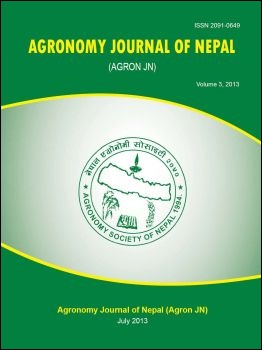Productivity and soil attributes as influenced by resource conservation technologies under rice- wheat system in Nepal
DOI:
https://doi.org/10.3126/ajn.v3i0.9007Keywords:
tillage and crop establishment, zero-tillage, permanent bed planting, crop residueAbstract
Rice-wheat system provides food, income, and employment to over 83 % of the people and contributes to national food security in Nepal. Sustainability of the system is under threat because of increasing cultivation cost and declining soil fertility. On-farm experiments were carried out to determine the effects of tillage and crop establishment methods, crop residue management, and nitrogen levels that affect soil attributes and productivity of the rice-wheat system during 2010- 2011at Bara, Nepal. The treatment consisted of three tillage and crop establishment methods viz. Conventional tillage (CT), Permanent bed planting (PB), and Zero-tillage (ZT); two residue management levels viz. Residue retention and Residue removal; and three nitrogen levels viz. Zero nitrogen, farmer’s dose (80 and 100 kgha-1 N for rice and wheat, respectively), and abundant nitrogen (120 kgha-1 N for both rice and wheat crop). The experiments were laid out in strip-split plot design with three replications. The research results revealed that rice grain yield was significantly higher in the plots receiving N level as applied by farmers that was similar to abundant nitrogen dose. Wheat grain yield was significantly higher with zero tillage compared to permanent bed planting and conventional tillage. Significantly higher wheat grain yield was also obtained due to abundant nitrogen dose than zero dose nitrogen which was similar to farmers’ dose of N as well. There was no significant difference in grain yield of rice and wheat due to residue retention, although, it improved soil moisture. In wheat crop, zero-till planting and increased nitrogen application conserved soil moisture, enhanced soil electrical conductivity and lowered soil temperature. It can be concluded that rice and wheat can be grown successfully with zero tillage and farmer’s nitrogen dose without any yield penalty.
Agronomy Journal of Nepal (Agron JN) Vol. 3. 2013, Page 64-72
Downloads
Downloads
Published
How to Cite
Issue
Section
License
ASON permits for free use, distribution and reproduction in any medium if the original work is properly cited and not used for commercial purposes.




